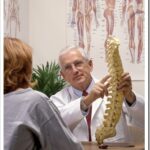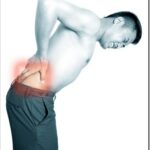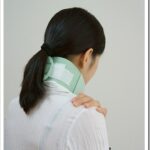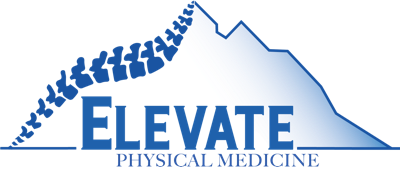We Can Help
Physical Medicine and Chiropractic Care work hand in hand providing effective treatments for a wide variety of conditions.
Below is a partial list of some of the most common conditions helped by our amazing physical medicine team at Elevate Physical Medicine. Our main things we help with are Knee Pain and Neuropathy. If you do not see your specific condition listed, please give us a call so we can personally address your specific concerns.
 Because asthma and many allergic reactions are caused by a hypersensitive immune system and/or respiratory system, they fall comfortably within the remit of chiropractic care. This is because, for your immune system and respiratory system to function well, they must rely on healthy communication from the brain and the spinal cord.
Because asthma and many allergic reactions are caused by a hypersensitive immune system and/or respiratory system, they fall comfortably within the remit of chiropractic care. This is because, for your immune system and respiratory system to function well, they must rely on healthy communication from the brain and the spinal cord.
A misaligned neck can easily cause your nervous system to become imbalanced. When the upper cervical spinal joint is irritated, it can provoke or worsen asthmatic and allergic symptoms. It is quite common, for example, to see victims of accidents involving this part of the spine to experience the onset or deterioration of an allergy such as asthma.
A doctor of chiropractic can assess your individual circumstances and examine your upper cervical spine to determine if their treatment will benefit your particular allergy.
 When most people think of an allergy they think of asthma. Asthma and many other allergies can be treated with chiropractic care because they are caused by a hypersensitive immune system and/or respiratory system. To function correctly, these require good communication from the brain and the spinal cord, and a misaligned neck can create an imbalance that degrades this communication.
When most people think of an allergy they think of asthma. Asthma and many other allergies can be treated with chiropractic care because they are caused by a hypersensitive immune system and/or respiratory system. To function correctly, these require good communication from the brain and the spinal cord, and a misaligned neck can create an imbalance that degrades this communication.
Irritation in the upper cervical spinal joint can sometimes produce or worsen asthma, and it is not unusual for people who’ve suffered trauma to this area to develop asthma where none existed, or to experience a deterioration of a pre-existing condition.
A doctor of chiropractic can check whether your asthma is related to upper cervical spine problems, and suggest a course of treatment to help alleviate the symptoms.

Car accidents are renowned for causing whiplash injuries, and these should always be taken seriously no matter how innocuous they may at first appear, because of the areas which are affected. It should also be remembered that the effects of whiplash may take weeks or months to fully manifest, thus it cannot be assumed no problems exist just because none is felt immediately following the accident.
Whiplash refers to a group of injuries that occur as a result of the sudden, violent whipping motion of the head in an accident. The whip can happen in any direction – back-forward, forward-back, side-side, or anything in between. Various injuries can result, including damage to the supporting muscles, ligaments and other connective tissues in the neck and upper back. A host of related symptoms can then kick off from these, many of which, to the untrained eye, can appear completely unconnected to the original trauma.
If you are not very careful, a whiplash injury may end up causing permanent damage when it is not noticed or its effect is underestimated. Around 50% of whiplash victims who have settled insurance claims are still suffering the effects of their whiplash years later. If you even suspect that you have suffered such an injury, a visit to your chiropractor is strongly advised so an assessment can be made and appropriate treatment and advice offered.

Carpal Tunnel Syndrome (CTS) is caused by pressure on the median nerve, located just above the wrist. It is one of the most common occupational health problems, affecting millions of people every year, largely thanks to our ever-increasing use of computers. Anyone can develop CTS, however, even if they are computer-phobic, as it is essentially a repetitive stress injury. This means anyone involved in repeated actions for extended periods may suffer from it, or it may be brought on by a trauma to that area.
Common symptoms of CTS include wrist pain, weak grip, numbness, tingling, and burning. The pain may also cause problems sleeping. Treatments vary and can include drugs and invasive surgery, but one that is both conservative and very effective is chiropractic. Adjustments made to the affected area can help resolve the issue, as can work on certain areas of the back or neck, where the nerves are being impinged upon and referring pain to the wrist. Chiropractic treatments may also include physical therapy, and stretching and strengthening exercises. Many people with CTS have found that they experience great relief from their symptoms after visiting a doctor of chiropractic.

Very few people avoid ever getting a headache, and they appear in many different ways. They may affect the whole head or just a part. They may be felt as anything from a dull ache to a sharp stabbing. They can last a few minutes or a few days. Some people feel nauseous, others don’t. Rarely do they indicate anything serious, but some do require urgent medical attention.
There are many reasons for headaches, including drug reactions, temporomandibular joint dysfunction (TMJ), tight neck muscles, low blood sugar, high blood pressure, stress and fatigue, but most can fit into one of two categories: tension (cervicogenic) headaches and migraine headaches. A third less common category is called cluster headaches, and is similar to the migraine.
Tension Headaches
These are the most common type, affecting around 75% of sufferers. They usually appear as a constant dull ache that affects one or both sides of the head, and some people describe them as the feeling of a tight band around the head or behind the eyes. They tend to come on slowly in the middle or toward the end of the day and can last anything from minutes to days, or occasionally months. Although the pain can be severe, there are not usually any other symptoms, such as nausea or vomiting.
As the name suggests, tension headaches are caused by stress, which includes bad posture throwing stress into the spine and muscles in the upper back and neck. In fact, the main cause of tension headaches is subluxations in these areas, especially the upper neck, combined with active trigger points. When tension causes the top cervical vertebrae to lose their normal motion or position, a small muscle called the rectus capitis posterior minor (RCPM) goes into spasm. This muscle has a tendon which channels between the upper neck and the base of the skull, attaching to the thin covering of the brain called the dura mater. While the brain itself has no feeling, the dura mater is very pain-sensitive and is pulled at when the RCPM goes into spasm, causing a headache.
Referred pain from trigger points in the sternocleidomastoid (SCM) or levator muscles are another major cause of tension headaches. These are located on the side of the neck and particularly affect those people who’ve suffered a whiplash injury.
Migraine Headaches
Around 25 million people a year in the U.S. experience migraine headaches, 75% of whom are women. Migraines are characterized by intense pain and throbbing, often coupled with nausea and sensitivity to light or noise. Their duration may be a few hours to several days, and there is sometimes a precursory visual symptom known as an “aura” that alerts the sufferer to the coming attack. This aura may be experienced as flashing lights or a dream-like appearance to the world.
Migraines tend to run in families and sufferers usually have their first attack before they reach 30 years old. Apart from this, the experience varies, with some people having several attacks every month, others perhaps once a year. They may also become more or less severe as the sufferer gets older.
The process of a migraine headache is that the blood vessels in the brain firstly constrict, and then dilate. The constriction decreases the blood flow, causing the visual symptoms many people experience. Even if an aura does not occur, most sufferers know when a migraine is nearing. When the blood vessels then dilate, the rapid increase in blood pressure is what leads to the pounding headache, which thumps in time to the heartbeat.
Why exactly the blood vessels constrict is not fully understood, although several common triggers have been identified. These include lack of sleep, stress, flickering lights, strong smells, a change of weather, and certain foods – the chief culprit being the amino acid tyramine.
Cluster Headaches
Cluster headaches are normally felt on one side of the head behind the eyes, and this is the only headache that usually occurs at night. They don’t normally last long, but they are excruciating. Around 1 million people in the United States suffer this type of headache, and, unlike migraines, more men than women are affected. They are termed cluster headaches as they tend to hit up to four times a day over several days. The good news is that another bout may not occur again for months or years. Cluster headaches are similar to migraines in that they are likely caused by a dilation of the blood vessels in the brain.

After upper-respiratory infections, back pain is the second most common reason for visiting a doctor. It will affect 80% of us at some point in our lives, and half of all adults are estimated to suffer this every single year, with over 10% of people suffering ongoing bouts of low-back pain.
Low-back pain can result from many conditions, such as sprained ligaments, strained muscles, ruptured disks, myofascial pain (muscular trigger points), and inflamed joints. It can happen following an obviously traumatic incident such as during hard sport, or it can be triggered by something as simple as sneezing where a weakness existed previously. It may also be the result of conditions such as arthritis, bad posture, obesity, mental stress, kidney stones, kidney infections, blood clots or bone loss.
This great variety of causes means it is very important not to assume the reason for any low-back pain you may be experiencing. Professional help should be sought to identify the problem, or to at least rule out anything more serious. Doctors of chiropractic are specially trained in assessing low-back pain, and offering appropriate treatment.
Common Causes of Low-Back Pain
Subluxations – This refers to disruptions in the normal movement or position of the vertebrae, resulting in often debilitating pain and inflammation. In the lumbar spine, it is the point between the lower spine and the sacrum that is most usually subluxated. Thankfully, chiropractic treatment can effectively remedy subluxations, reducing pain and inflammation, and this improvement is often instantly felt following treatment.
Herniated discs – It may surprise you that a herniated disc does not necessarily cause any discomfort in the low back. One study showed that half of those adults suffering from herniated or bulging discs did not even know it. However, a herniated disc can refer serious pain to other parts of the body, and they rarely recover to their previously perfect state. Chiropractic care is an effective way to retard this deterioration.
Sprains, strains and spasms – Individuals who lead fairly sedentary lives during the week and then go a little crazy at the weekend are most prone to this kind of low-back pain. Someone who perhaps has a game of soccer or a hard game of squash to blow out the cobwebs can end up overstressing themselves very quickly, suffering injuries that cause pain and inflammation.
Stress – Mental stress causes your blood pressure and heart rate to rise, and stress hormones to flood your system. This leads to a tightening of the muscles, which are then more susceptible to injury. Ongoing muscular tension makes them weak, sore and full of trigger points – small concentrated knots that refer pain to other parts of the body, sometimes quite distant from the trigger point. Relaxation techniques, breathing exercises, and physical exercise are all important in combating stress.

Osteoporosis is a metabolic disease characterized by bone loss and the degradation of bone structure. It affects more than 200 million people globally and there are 10 million sufferers in America. There are an additional 18 million people in the U.S. who have low bone mass. Those 28 million constitute 10% of the population, making osteoporosis something of an epidemic.
It is the weight-bearing bones that are chiefly affected by osteoporosis – the pelvis, femur (thigh bone), and lumbar vertebras. Naturally, bone loss in these structures can lead to serious fractures with potentially devastating results.
Osteoporosis can be brought on by many conditions, circumstances, and deficiencies. The menopause is strongly linked to the condition, as are being over 50 years old, smoking, inadequate calcium, vitamin D, and dietary protein, and a lack of exercise.
Consistent weight-bearing exercise is very important to strengthen the vulnerable bones and prevent loss of bone mass. Walking, running, cycling, and strength-training exercises all stimulate both your muscles and bones to build up stronger. This physiologic bone-building response is known as Wolff’s law, which says that bone remodels when physiologically stressed. In other words, mechanical challenges cause your bone to build more bone, producing stronger, denser bones that are much less likely to fracture.

People may say they have a “pinched nerve” when they are suffering pain from an unidentified source. It may actually be caused by spinal subluxations, a tunnel syndrome, the referred pain from trigger points, or something else.
So-called pinched nerves are more usually just irritated or inflamed because the bones, joints or muscles of the spine are not in their proper position, or not moving correctly. This condition is the aforementioned “subluxation”, which the doctor of chiropractic specializes in correcting.
Those times when nerves do genuinely become “pinched” include Carpal Tunnel Syndrome, Sciatica and Thoracic Outlet Syndrome. These involve an injury, spasm or inflammation that causes the surrounding muscles and connective tissue to compress the nerve, resulting in pain. These conditions are called “tunnel syndromes”, and although the chiropractic treatment of these is more complex than dealing with a simple spinal subluxation, they usually respond very well, especially when combined with exercises, stretching, and massage, etc.
Trigger points are very small and tight “knots” in the fibers of the muscle that form when the muscles become chronically overworked or injured. Pain from trigger points is very often referred to other parts of the body that may seem wholly unrelated to the source. Trigger points can be successfully treated by a combination of chiropractic care, stretching, and a precise deep tissue massage known as “trigger point therapy”.
Pain of any sort must be properly diagnosed before it can be effectively treated, especially when it is the nerves that are affected. Otherwise, the nerve may end up being permanently damaged. Being told by your doctor that you have a “pinched nerve” should not be viewed as a diagnosis; only as an indication that further investigation by a doctor of chiropractic is required as soon as possible.

The sciatic nerve runs from your pelvis, through your hip area and buttocks and down each leg, and it is the longest nerve in your body. As it travels down the legs it branches into smaller nerves that provide feeling to your thighs, legs, and feet, and serve to control many of the muscles in your lower legs. The pain that sometimes radiates along the path of this nerve is called sciatica.
Causes of sciatica
Sciatica is a sign that something is putting undue pressure on a nerve in your lower back. Most usually, the nerve is being compressed by a bulging or herniated lumbar disc. Another cause is piriformis syndrome, which happens when the piriformis muscle lying directly over the sciatic nerve becomes tight or goes into spasm, putting pressure on the nerve. Men can occasionally suffer sciatica from sitting for too long on a wallet in their back pocket.
Pain pattern of sciatica
The classic sciatic pain is that which radiates from your lower spine to your buttock and down the back of your leg. This may be accompanied by numbness, tingling, and muscle weakness in the affected leg. The severity of the pain can vary from a mild ache, to a sharp burning, to excruciating discomfort. Sometimes, the pain may feel akin to an electric shock. Sciatic pain usually comes on gradually and worsens over time, and can be exacerbated by when you sit, cough or sneeze.
Treatment of sciatica
Sciatic pain can very often be relieved through a treatment combination that includes chiropractic care, stretching, and deep tissue massage (trigger point therapy) of the piriformis muscle. When the piriformis muscles are identified as the main culprits and pain is chronic, a trigger point injection may be needed, whereby a small amount of anesthetic is injected directly into the muscle to break the cycle of spasms, although this is not commonly required.

Scoliosis begins in childhood, and describes a condition in which the spine curves sideways causing stiffness and pain. It is known as an idiopathic disease, meaning the cause of it is unknown. Only 2% of the population is affected by scoliosis, and it is more common in females. Detected early, treatment for scoliosis will prevent it from getting worse over time.
The sideways curve in the spine of a scoliosis sufferer takes an “S” or “C” shape, and is possible because the vertebrae can rotate at the thoracic level of the spine, causing a hump near the rib cage and making the waist or shoulders uneven. A curve of more than 60 degrees is considered serious, and, unlike with the normal forward-back curvature of the spine, working to correct your posture will not help this sideways curvature.
Degenerative diseases of the spine related to age can also sometimes cause scoliosis. In the case of osteoporosis, the softening of the bones in older people can cause the vertebrae to bend out of shape, creating either a scoliotic curve or kyphosis (round back). Proper and prompt treatment for scoliosis is essential, because if left to progress, it can cause severe back pain, deformity, and difficulty breathing.

A “slipped disc” – often synonymous with a low back (lumbar) injury – is a misnomer because discs do not actually slip; they herniate or bulge out from between the bones. A herniation happens when a fragment of the center part (nucleus) of the disc is displaced and pushes through a tear in the outer layer (annulus) of the disc. When irritating substances are released from this tear, or if the fragment affects a nearby nerve, then pain is caused. This process is similar to degenerative disc disease, and herniations can be an early stage of degeneration.
Causes of herniated discs
Discs can herniate due to various factors that decrease their strength and resilience. This can include certain lifestyle choices such as smoking, lack of exercise, and poor nutrition. Discs are further stressed by daily wear and tear poor posture, from injury or trauma, or incorrect lifting or twisting. A weakened disc can sometimes herniate from something as simple as a single everyday movement or strain, such as coughing, sneezing or bending.
Signs of a herniation
You are more likely to suffer a herniated disc between the ages of 30 and 40, and you may not even know it when it happens as it may not cause any pain. The most common symptom, though, is a pain in the herniated disc that may radiate out into the hips or buttocks, or pain or numbness radiating down the leg to the ankle or foot. A large herniation may cause weak extension of your big toe and trouble putting pressure on your toes or heels when walking. Severe cases may even prompt changes in bowel or bladder function, and/or sexual function.
Treatment of a herniated disc
Chiropractic care, stretching, and exercise therapy is often sufficient to treat mild to moderate disc herniations. More serious cases will often require chiropractic care be coupled with some form of spinal decompression, such as traction or mechanical decompression.
As a last resort, surgery may be needed when a herniation is severe and all other treatment options have failed to bring improvement, or if the spinal cord or nerves are too badly compressed.

Stress can hit you from many angles, for many different reasons, mental and physical. Job security, working too hard, not working at all, commuting, relationships, illness, worry about a loved one, lack of sleep, retirement, bereavement, moving house – all can serve to create stress. A recent survey by the American Psychology Association revealed that 54% of Americans are concerned about their stress levels, and two-thirds would likely seek help for their stress.
Many people are stressed without really knowing it; it’s just the way of modern life and we get used to it. However, it still creates genuine strains on your body that are manifested as an increase in: blood pressure, heart rate, respiration, metabolism, and blood flow to your muscles. This is your primitive fight-or-flight reaction kicking in, preparing you for action in the face of a stressful situation.
The Stress Response
Your stress (fight-or-flight) response, while useful in threatening and dangerous situations to preserve life and limb, is not healthy when it pretty much never goes away. Nowadays, it is rarely triggered in response to an aggressor who must be fought off or a predator that must be fled from; instead, as an ongoing reaction to life’s stresses, it is highly likely to be harmful to your health.
Of course, different people will react to the same situation in different ways. It is not the situation, then, as much as the individual’s reaction to it. What might stress one person may not bother another.
 If you think about the mechanics of your neck, you’ll realize it’s not surprising how easily it can be injured. It has amazing flexibility, is constantly on the move, has very little muscular support, but has to support the 14 – 16 pounds of your head. It is like balancing a bowling ball on a stick using only elastic bands.
If you think about the mechanics of your neck, you’ll realize it’s not surprising how easily it can be injured. It has amazing flexibility, is constantly on the move, has very little muscular support, but has to support the 14 – 16 pounds of your head. It is like balancing a bowling ball on a stick using only elastic bands.
Consider that your spinal cord runs down a space in the centre of the vertebrae, which protects it from harm. Along large bundles of nerves running out from between each pair of vertebrae, nerve impulses are sent to every part of the body. From your cervical vertebrae, impulses are sent to your arms, and some into your upper back. Thus pain in your arm, such as numbness, tingling, cold, aching, or “pins and needles”, may be referred from the neck. People with neck problems may mistake their pain for carpal tunnel syndrome, a condition in the hands that is often caused by repeating the same repetitive motions for long periods.
Neck problems can also lead to headaches, muscle spasms in the shoulders and upper back, ringing in the ears (tinnitus), inflammation in the middle ear (otitis media), temporomandibular joint dysfunction (TMJ), or simply a restricted range of motion and severe tightness in the neck and upper back. Issues from the neck can show up in the upper back because many neck muscles originate there, including the trapezius, the levator scapulae, the cervical paraspinal muscles and the scalenes.
 To achieve overall wellness, you should be taking regular chiropractic treatment, eating a healthy diet, taking nutritional supplements, keeping to your ideal weight, and managing your stress levels. If you can do this, you are far more likely to enjoy a longer, healthier, more pain-free life.
To achieve overall wellness, you should be taking regular chiropractic treatment, eating a healthy diet, taking nutritional supplements, keeping to your ideal weight, and managing your stress levels. If you can do this, you are far more likely to enjoy a longer, healthier, more pain-free life.

“Whiplash” as a term originated in 1928 to describe an injury resulting from sudden hyperextension of the neck immediately followed by hyperflexion. This resulted in damage to the surrounding muscles, ligaments and tendons, especially those supporting the head. Nowadays we take a different view in that we remove the “hyper” part which refers to extension and flexion beyond normal physiological limits. Whiplash now simply refers to an extremely rapid extension and flexion that cause injury. It is the sudden movement that causes the damage, not necessarily movement beyond what we can normally manage.
Considering the ease with which the term is bandied about – normally in relation to insurance claims – few people will be unaware of the problem. For the medical profession, it is notorious for different reasons. Whiplash injuries are often far from straightforward as they involve an unpredictable combination of insults to any or all of the nervous system, the muscles, the joints, and the connective tissues. These are frequently both difficult to diagnose and to treat. Long-term effects can be even more distressing and mysterious.
Hours
| Mon | By appointment only |
| Tue | By appointment only |
| Wed | By appointment only |
| Thu | By appointment only |
| Fri | By appointment only |
ELEVATE Physical Medicine
700 Squires Point Suite B
Duncan, SC 29334 (map)
Phone: (864) 336-5020

